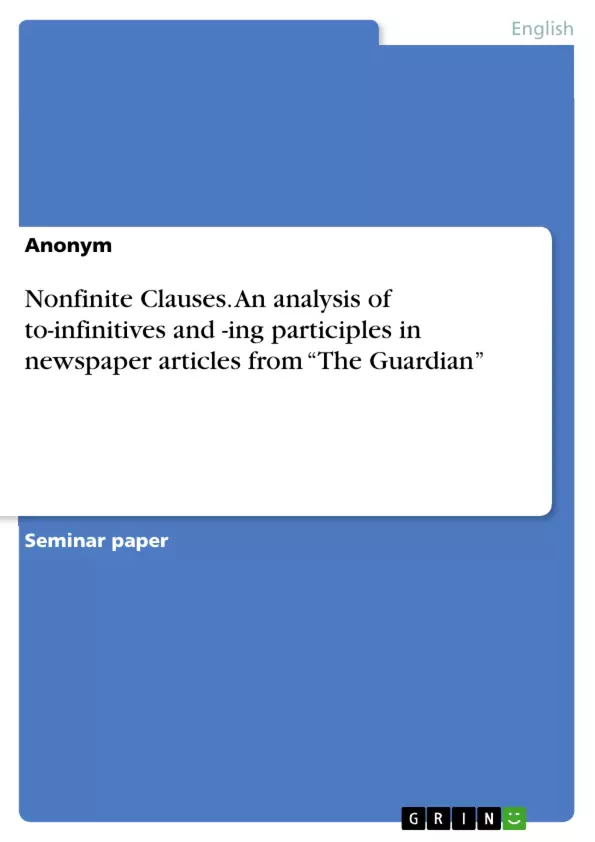The present study focuses on nonfinite clauses as one of the three main types of clauses aside from finite clauses and verbless clauses. The aim of this paper is to analyse the structural classes of to-infinitives and –ing participle clauses concerning their realizations on the clause level as well as the phrase level. In Section 5 the theoretical background knowledge to the analysis of three newspaper articles from “The Guardian” is applied along the lines of these features.
“Language is the most massive and inclusive art we know, a mountainous and anonymous work of unconscious generations.” Edward Sapir, a poet as well as pioneer linguist, draws our attention to the great diversity that language itself holds. Even the small section of Sentence Analysis presents a great many points of interest that would be worth analysing and applying on a text.
Inhaltsverzeichnis (Table of Contents)
- Introduction
- Past research: Theoretical Background
- Structural classes
- Embedded nonfinite clauses on the clause level
- Subject
- Direct Object
- Subject Complement
- Object Complement
- Adverbial
- Embedded nonfinite clauses on the phrase level
- Noun Phrase
- Adjective Phrase
- Prepositional Phrase
- Present research question: Application of theoretical background
- Methods and data: Analysis of three newspaper articles
- Results: Quantitative and Qualitative Analysis
- Quantitative occurrence of nonfinite clauses
- Qualitative appraisal of embeddedness on the clause level
- Subject
- Direct Object
- Subject Complement
- Object Complement
- Adverbial
- Quantitative appraisal of embeddedness on the phrase level
- Noun Phrase
- Adjective Phrase
- Prepositional Phrase
- Discussion and Conclusion
Zielsetzung und Themenschwerpunkte (Objectives and Key Themes)
This paper aims to analyze the structural classes of to-infinitives and -ing participle clauses, focusing on their realizations on both the clause and phrase levels. The study will examine the use of these nonfinite clauses in three newspaper articles from "The Guardian," applying the theoretical background knowledge gained from previous research.
- Structural classes of nonfinite clauses, particularly to-infinitives and -ing participles
- Embedded nonfinite clauses on the clause level (e.g., subject, object, complement)
- Embedded nonfinite clauses on the phrase level (e.g., noun phrase, adjective phrase, prepositional phrase)
- Analysis of nonfinite clause usage in newspaper articles
- Quantitative and qualitative analysis of nonfinite clause occurrences and functions
Zusammenfassung der Kapitel (Chapter Summaries)
- Introduction: This chapter introduces the topic of nonfinite clauses and their significance in sentence analysis. It highlights the study's focus on to-infinitives and -ing participle clauses, emphasizing their prevalence in newspaper articles.
- Past research: Theoretical Background: This chapter reviews existing research on nonfinite clauses, providing a theoretical framework for the study. It examines the structural classes of nonfinite clauses, particularly to-infinitives and -ing participles, and explores their functions on both the clause and phrase levels.
- Present research question: Application of theoretical background: This chapter presents the research question guiding the study, which involves applying the theoretical background knowledge of nonfinite clauses to the analysis of newspaper articles.
- Methods and data: Analysis of three newspaper articles: This chapter outlines the methodology and data used in the study, focusing on the analysis of three selected newspaper articles from "The Guardian."
- Results: Quantitative and Qualitative Analysis: This chapter presents the findings of the study, encompassing both quantitative and qualitative analyses. It examines the frequency of nonfinite clause occurrences and explores their specific functions within the analyzed articles.
Schlüsselwörter (Keywords)
The main keywords and focus topics of this study include nonfinite clauses, to-infinitives, -ing participles, structural classes, embedded clauses, clause level, phrase level, newspaper articles, "The Guardian", quantitative analysis, qualitative analysis.
- Quote paper
- Anonym (Author), 2013, Nonfinite Clauses. An analysis of to-infinitives and -ing participles in newspaper articles from “The Guardian”, Munich, GRIN Verlag, https://www.grin.com/document/323736



